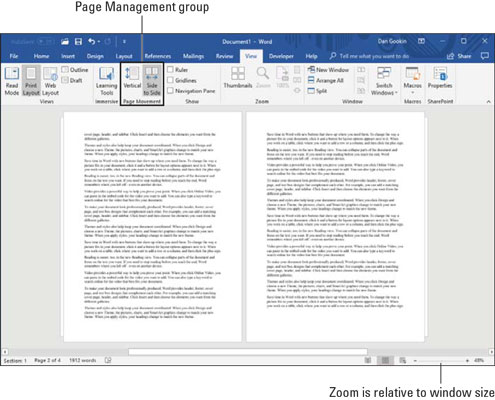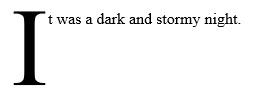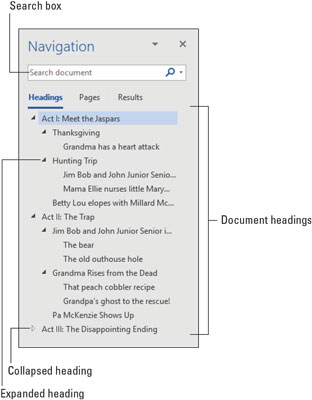Side-to-Side Page Movement in Microsoft Word
In Print Layout view, you can arrange the document window to display pages side-to-side, as illustrated. Workflow moves down the left page and then hops up to the top of the right page. This arrangement takes full advantage of widescreen computer monitors. Working on a document side-to-side.
Working on a document side-to-side.To enter Side-by-Side view, click the View tab and in the Page Movement group, choose Side-to-Side. You may need to adjust the Word window to enlarge the document presentation; the Zoom command is disabled when you activate Side-to-Side page movement. So, the wider you can make the document window, the better things look.
In the Side-to-Side presentation, the horizontal scroll bar becomes more useful. Use it to page through the document. The pages automatically flip as you edit and create text.
To restore traditional document presentation, click the Vertical button. You can also switch document views, though when you return to Print Layout, Side-to-Side presentation is restored.
Automatic Save with AutoRecover in Word 2019
Someday, you will sing the praises of Word's AutoRecover feature. It periodically saves your document, even when you neglect to do so. In the event of a computer crash or some other mishap, Word recovers your document from a supersecret safety copy it secretly made for you. How nice.To ensure that AutoRecover is active, heed these directions:
- Click the File tab.
- On the File screen, choose Options. The Word Options dialog box appears.
- Choose Save.
- On the right side of the dialog box, ensure that a check mark appears by the item Save AutoRecover Information Every 10 Minutes. You can change the time, though 10 minutes seems good.
- Click OK to close the window. Whew! You're safe.
The best way to avoid accidentally losing stuff is to save now and save often!
Accelerate the Word 2019 Ribbon
Word has always been a mouse-based program, even when it ran in Text mode on old DOS PCs. Still, the keyboard remains a fast and effective way to access commands, especially given that in a word processor, your fingers are hovering over the keyboard most of the time.If you’re willing to learn, eschew the mouse and instead use some keyboard accelerators to access commands on the Ribbon.
The secret is to use the Alt key: Tap Alt and you see letters in boxes appear on the Ribbon, like tiny square freckles. Within each box are one or two letters, which are the accelerator keys. Tap a letter or the two letters in sequence to “click” a specific part of the Ribbon.
For example, to change the page orientation to Landscape mode, you press Alt, P, O to display the Orientation menu. Press the down-arrow key to choose Landscape. Press Enter to choose that menu item.
- If you accidentally tap the Alt key, press it again to exit Accelerator mode.
- You can also press the F10 key to access the Ribbon accelerators.
Ancient Word Keyboard Shortcuts
Before the Ribbon rode into town and freaked out all the townsfolk, Word relied upon keyboard commands. These ancient Word keyboard shortcuts still work in Word today. They’re handy, though not too memorable.F4: The F4 key is the Repeat key, exactly the same as Ctrl+Y, the Repeat key.
Shift+F4: Another repeat key, but this one is the Repeat Find command. It works even when the Find dialog box (or navigation pane) isn’t visible.
Shift+F5: This key combo is the Go Back command, which returns to the spot you last edited.
Shift+F8: The Shrink Selection key is the opposite of the Selection key, F8. For example, when the entire document is selected, press Shift+F8 to select only the current paragraph. Press Shift+F8 again to select only the current sentence. Press it again to select only the current word. Press Shift+F8 one more time to deselect the word.
F12: Tap this key to quickly summon the Save As dialog box. I use this key a lot because it’s quicker than wading through the Backstage to summon the Save As dialog box.
Ctrl+F12: This key does for the Open dialog box what F12 does for the Save As dialog box. It’s not redundant to the Ctrl+O command, which conjures the Backstage. Ctrl+F12 always brings up the good ol’ Open dialog box.
Build Your Own Fractions in Microsoft Word
Word's AutoCorrect feature builds common fractions for you, replacing your clumsy text with fraction characters. Sadly, Word has only a few of these fraction characters. When you need your own, custom fraction, such as- Press Ctrl+Shift+= (the equal sign), the keyboard shortcut for the superscript command.
- Type the numerator — the top part of the fraction.
For example, type 3 for
 .
. - Press Ctrl+Shift+= again to disable superscript.
- Type the slash character ( / ).
- Press Ctrl+= to activate subscript.
- Type the denominator — the bottom part of the fraction.
For example, type 64 for
 .
. - Press Ctrl+= to turn off subscript.
Electronic Bookmarks in Microsoft Word
When you must find your place in a document, you can write text like WORK HERE, or you can take advantage of Word’s Bookmark command. The bookmark is invisible, but Word knows where it is. You can use the bookmark to return to a page for editing, to add a cross-reference, or to perform a bunch of other handy tricks. Set a bookmark by following these steps:- Place the insertion pointer where you want to insert the bookmark.
- Click the Insert tab.
- In the Links group, click the Bookmark button. The Bookmark dialog box appears.
- Type a name for the bookmark in the Bookmark dialog box. Try to keep the bookmark name to one word, letters only.
- Click the Add button. The bookmark is created.
Lock Your Microsoft Word Document
When you really, really don’t want anyone messing with your sweet text, you can lock the document. Several levels of protection are available, but you start the journey by following these steps:- Click the File tab.
- Choose Info.
- Click the Protect Document button. Of the several choices, I recommend these options:
- Mark as Final: The document is flagged as final, which means that further editing is disabled. Still, you can easily override it by clicking the Edit Anyway button that appears.
- Encrypt with Password: The document is encrypted and a password is applied. To open the document in Word, you must enter the password. You cannot remove a password after it’s applied.
- Restrict Editing: You can limit whether a user can edit a document or whether all changes are tracked or restrict that person to make only comments.
- Choose an option and answer the questions in the dialog boxes that appear.
- Click OK. The document protection you’ve chosen is applied.
Locking your document is a serious decision! No one can help you if you forget a password or are otherwise unable to remove the restrictions you’ve applied to the document.
The Drop Cap in Microsoft Word 2019
A drop cap is the first letter of a report, an article, a chapter, or a story that appears in a larger and more interesting font than the other characters. The figure shows an example. A drop cap.
A drop cap.To add a drop cap to a document, follow these steps:
- Select the first character of the first word at the start of the text. For example, select the I in It was a dark and stormy night.
- Click the Insert tab.
- In the Text group, click the Drop Cap button.
- Choose a drop cap style. And there’s your drop cap.
To remove the drop cap, choose None in Step 4.
Map Your Word 2019 Document
Whenever I’m writing, I show the navigation pane on the left side of the document window. This pane lets me see the Big Picture, an overview of my document based on the heading styles. I can use it to quickly hop to a specific header. As a bonus, it also shows the handy Search Document text box, as illustrated here. The navigation pane document map.
The navigation pane document map.To summon the navigation pane, follow these steps:
- Click the View tab.
- In the Show group, click to put a check mark by the Navigation Pane item.
The navigation pane replaces a popular but long-gone Word feature called the Document Map.
Sort Your Microsoft Word Text
Sorting is one of Word’s better tricks, though it’s surprising how few people know about it. You can use the Sort command to arrange text alphabetically or numerically. You can sort paragraphs, table rows and columns, and more.Save your document before sorting. It's just a good idea.
Sorting isn’t difficult. First, arrange whatever needs to be sorted into several lines of text, such asLemon
Banana cream
Apple
Cherry
Rhubarb
Tortilla
After you know what you’re going to sort, obey these steps:
- Select the lines of text (or parts of a table) as a block.
- Click the Home tab.
- In the Paragraph group, click the Sort button.
 The Sort Text dialog box appears. It’s most useful when sorting multicolumn items, which is where the Then By parts of the dialog box are most useful.
The Sort Text dialog box appears. It’s most useful when sorting multicolumn items, which is where the Then By parts of the dialog box are most useful. - Choose Ascending or Descending to sort the text from A to Z or from Z to A, respectively.
- Click the OK button.






